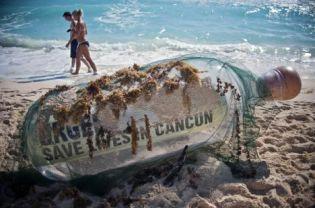 Cancun, Mexico. Cancun’s eroding white sand beaches are providing a note of urgency to the climate talks being held just south of this seaside resort famed for its postcard-perfect vistas.
Cancun, Mexico. Cancun’s eroding white sand beaches are providing a note of urgency to the climate talks being held just south of this seaside resort famed for its postcard-perfect vistas.
Rising sea levels and a series of unusually powerful hurricanes have aggravated the folly of building a tourist destination atop shifting sand dunes on a narrow peninsula.
After the big storms hit, the bad ideas were laid bare: Much of Cancun’s glittering hotel strip is now without a beach.
Hotels built too tall, too heavy and too close to the shore, as well as beaches stripped of native vegetation to make them more tourist-friendly, have contributed to the massive erosion.
“It was the chronicle of a disaster foretold,” said Exequiel Ezcurra, the former head of Mexico’s environmental agency.
“Everybody knew this was going to happen. This had been predicted for 40 years.”
Cancun’s beaches largely disappeared after Hurricane Wilma, a category-4 storm, hit in 2005, leaving waves lapping against hotel foundations or rocks.
The coastline erosion is exacerbated by a rising sea level of about 2.2 millimeters a year.
In a major restoration project last year, millions of cubic meters of sand were dredged from the sandy bottom of the Caribbean and pumped ashore in Cancun. The $70 million project created an 11-kilometer stretch of beach 40 to 70 meters wide.
It is already washing away.
Waves have carved a waist-high shelf into the beach and Assistant Tourism Secretary Hector de la Cruz acknowledges that 6 to 8 percent of the new sand has been swept away — even without any major storms.
It was the second time such an undertaking had been tried; a $19 million beach restoration effort in 2006 also washed away, finished off by a category-5 hurricane, Dean, that hit further down the coast in 2007.
“In a year or two, another hurricane will come and the same thing will happen all over again,” said Fernando Garcia, a tourist from Spain. “This is an absurd waste of money.”
In a financial sense, however, it still works. Cancun remains the biggest money-earner of all of Mexico’s tourist spots, bringing in about $3 billion per year .
However, the restoration efforts are having an impact on the ocean floor ecosystems where the sand was removed, and the coral reefs offshore.
The sand contains fine sediments that wash away with the tide from the newly restored beaches and onto the reefs, blocking out sunlight and causing them to secrete mucus-like substances, said Roberto Iglesias, a biologist from Mexico’s National Autonomous University.
Experiments are still under way to judge the exact effects, but there is evidence that sea grasses have suffered higher die-offs from previous beach restoration efforts, said Iglesias.
Iglesias recalled one local official saying the resort had to choose restoring the beaches over protecting coral reefs “because the majority of Cancun’s inhabitants make their living off the beaches, not the reefs.”




